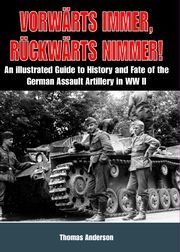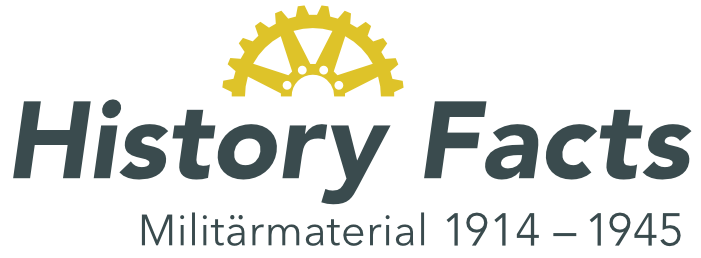Vorwärts immer - Rückwärts nimmer (Volume 1)
An Illustrated Guide to the History and Fate of the German Assault Artillery in WWII

The purpose of this first volume is to introduce this small, but remarkable service arm to the reader. Development and combat of of the first units in battery - scale and the later Sturmgeschütz battalions resp. brigades will be explained by photos, diagrams and colored artwork. The author turned his attention to the identification of Sturmartillerie units, markings and characteristics will be clarified wherever possible. During his research the author relied only on sources found in German archives. Subjective recollections of veterans have been used to illustrate the nature of this service arm.
This study includes 250 historical photographs, most published for the first time, 40 color illustrations (Drawings), 1 map and some tables of organisation. Format: 20*28 cm, 209 pages, Hardcover.
ISBN: 978-3-9522968-9-9
-
ExtractTable of Contents
Foreword
Birth of a branch of service
First units
Batallions
Appendix
Information about the book -
Reviewsamazon.com 09/10 (Doug Nash)
'Forwards ever, rearwards never! is the translation of the title, and let me start by saying that the book is entirely in English language, despite the German language title. This is the first new book in a series from the publisher 'History Facts', and is written by Thomas Anderson, an author with a strong interest in the German Assault Artillery of WW2. His name may be familiar to many modellers who may have noticed his name credited on a good many Dragon kits and other reference works. He has a long time interest in the assault artillery units, and now he is putting that to use in this new series of books from History Facts.
This first volume covers the early period of the Sturmgeschutz, with the early Stug IIIs with their short 75mm guns. Seen as useful for tackling enemy strongpoints, machine gun positions or bunkers, these were very much Assault Artillery, to be used for pin-point attacks on strongpoints that were holding up an advance...
The book is filled with informative text and a host of excellent period photos and unit organisation charts... The book takes us through that, the first use in combat in 1940, and tackles all the early units that were equipped with the early Panzer III based Stugs. The photos show the vehicles, including the supported variants of the little Sdkfz 252 ammunition carrier as well as the Stugs themselves, and their crews. In the barracks, on the training grounds and in action. Following the opening Introduction, the main segments of the book are the First Units... Very much a book, or to be more precise the first in a planned series of books, clearly by a modeller, and for modellers.
modelarmour.com 10/11 (Vinnie Branigan)
First in a three volume work, the others being Volume 2: Attack and Volume 3: Defence. Despite the title, that translates to 'Forwards Always - Backwards Never!', the book is entirely in English...which is nice. Also, it's mainly photographic in nature...which is also nice....'cos I likes me pictures. :)... The book examines the development and history of the German Sturmartillerie before and during WWII, using this first volume to also show their early deployments and actions. To do this, as I mentioned, the author makes extensive use of period black and white photographs, although don't let this mislead you to thinking the book is light on information. It's not. The captions to each of the reproduced photographs are fairly comprehensive, and there are lengthy text sections where necessary to impart relevant information. This not only includes the author's own research, but also the reproduction of official reports made at the time, maps and tales of organisation. After the introduction, six Sturmbatterie are covered in some detail, their formation, deployment and history, along with useful information on how to identify vehicles belonging to each specific unit, each of the sections being copiously illustrated with relevant period photographs.
The next section examines five Sturmartillerie- Abteilung during the period immediately after the invasion of France, again using photographs, tables of organisation and again including a lengthy section on identifying which particular vehicles belonged to whom. This is followed by a section on illustrating and describing the various types of uniform worn by the Sturmartillerie between 1939 and 1941, the final section being a large selection of colour plates of various vehicles from various units!
Conclusion If your particular area of interest is StuG's or the Sturmartillerie in general, then this is one series that you're going to consider a must have! Beautifully illustrated, and with another two volumes to collect, it looks set to become a standard work on the German Assault Artillery of WWII. Recommended.
Military Modelling International 10/11 (David Grummit)
MMI's own Thomas Anderson has written the first volume of what promises to be the definitive account of the German Sturmartillerie, or assault gun units, in World War II...
This instalment covers the Initial development of the Sturmartillerie, its first deployment in 1940 during the French campaign, its rapid expansion and subsequent action during Operation Barbarossa. The author, who acknowledges his debt to the renowned team of Jentz and Doyle (the foremost experts in the field), has based his research almost entirely on original German sources; no repeat here of the myths and errors which mar other publications. For the modeller this book contains a wealth of previously unseen photographs: no less than 250 across its 208 pages. Each is expertly captioned and Anderson has gone to great lengths to identify units, markings and other characteristics (such as stowage arrangements) that identified the different units. As well as the StuG III there are plenty of photographs and information on the Sd.Kfz. 252 and 253 support vehicles, as well as the support and recovery vehicles that served alongside the StuGs. The text and photographs are also supported by a wealth of colour profiles, unit markings and a map. Overall, this is a first-class production which I can't recommend highly enough.
Steel Art 10/11 (A.B.)
Questo libro dal titolo "Sempre avanti - indietro mai!" risulta rieeo di foto storiche e succose didascalie a corredo. Tratta della famosa Sturmartillerie nelle prime lasi della guerra. A questo ne dovrebbero seguire altri tre per coprire tutte le fasi dei conflitto. Il libro nasce dalla ricerca certosina dli famoso Thomas Anderson che ha intervistato centinaia di veterani per fornire un documento ricco di curiosità e scatti inediti, che sarà sicuramente giudicato fondamenlaie dagli appassionati. 11 volume e in formato A4 ed e rilegalo. Dentro troverete oltre alle loto disegni a colori dei mezzi. Eslratti di manuali e documenti ufficiafi. 11 tutto in lingua inglese.
missing-lynx.com 10/11 (Tom Cockle)
In English, the title translates to Forward ever, rearward never!, the motto of the newly formed Artillerielehrregiment training facility located in Jüterbog near Berlin in 1936. The book presents a chronological historical look at the creation of the first Sturmartillerie units beginning with the first six independent Sturmbatterien (640, 659, 660, 665, 666 and 667) in November 1939 and their battlefield experiences in the battle of France in May 1940. This is followed by an account of the creation of the first five Sturmartillerie-Abteilungen (184, 185, 190, 191 and 197) in July 1940 and their experiences during the Balkan Campaign.
Each unit is discussed in detail and includes a Table of Organization and numerous photographs illustrating the unit markings and support equipment. The book finishes off with a brief discussion on the uniforms used by the Sturmartillerie.
Most of the photographs are previously unpublished from the authors personal collection as well as from several veterans personal albums and other well known sources. I found it to be a very interesting read with enough technical information and descriptive photograph captions to keep my attention but not too much to make it boring and was able to finish it in about four hours. Anyone interested in the history and equipment of the German Sturmartillerie will find this book to be a valuable addition to their library.
